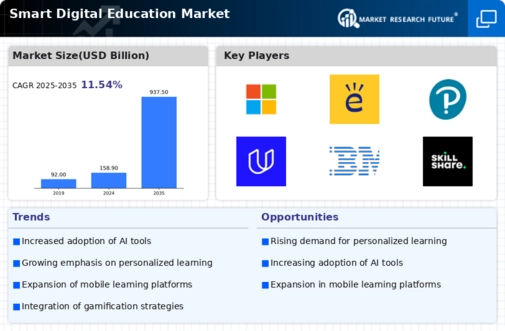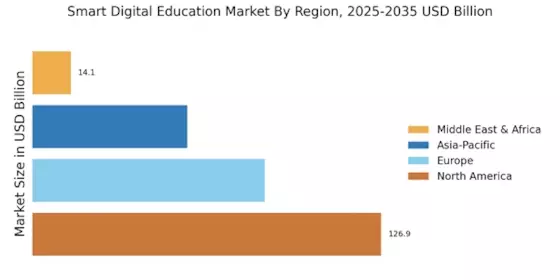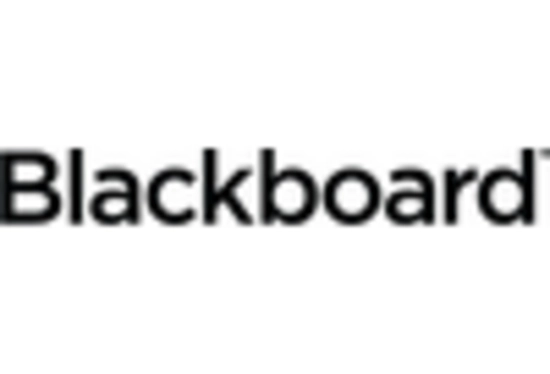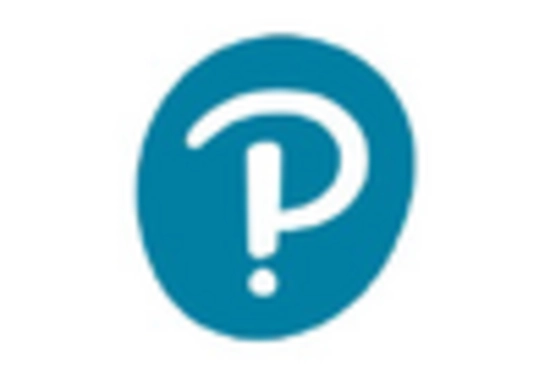The Smart Digital Education Market is currently characterized by a dynamic competitive landscape, driven by rapid technological advancements and an increasing demand for personalized learning experiences. Major players such as Google (US), Microsoft (US), and Coursera (US) are at the forefront, leveraging their extensive resources to innovate and expand their offerings. Google (US) focuses on integrating artificial intelligence into its educational tools, enhancing user engagement and learning outcomes. Meanwhile, Microsoft (US) emphasizes partnerships with educational institutions to facilitate digital transformation, thereby positioning itself as a leader in providing comprehensive educational solutions. Coursera (US) has adopted a strategy of diversifying its course offerings through collaborations with top universities, which not only broadens its market reach but also enhances its credibility in the digital education space. Collectively, these strategies contribute to a competitive environment that is increasingly centered around technological innovation and strategic partnerships.
In terms of business tactics, companies are increasingly localizing their offerings to cater to diverse educational needs across different regions. This localization, coupled with supply chain optimization, allows for more tailored educational solutions that resonate with local markets. The Smart Digital Education Market appears to be moderately fragmented, with a mix of established players and emerging startups. The collective influence of key players is significant, as they set industry standards and drive trends that smaller companies often follow.
In August 2025, Google (US) announced the launch of its AI-driven learning platform, which aims to personalize educational content based on individual learning styles. This strategic move is likely to enhance user engagement and retention, positioning Google (US) as a frontrunner in the integration of AI within educational frameworks. The emphasis on personalized learning experiences aligns with current trends in the market, where customization is increasingly valued by both educators and learners.
In September 2025, Microsoft (US) expanded its partnership with several educational institutions to implement its cloud-based solutions, facilitating remote learning and collaboration. This initiative not only strengthens Microsoft’s foothold in the education sector but also underscores the growing importance of cloud technology in delivering effective educational experiences. By enhancing accessibility and collaboration, Microsoft (US) is likely to attract a broader user base, further solidifying its competitive position.
In October 2025, Coursera (US) launched a new initiative aimed at providing free access to its courses for underserved communities. This strategic action reflects a commitment to social responsibility while simultaneously expanding its user base. By addressing educational inequities, Coursera (US) not only enhances its brand image but also positions itself as a leader in promoting inclusive education, which is increasingly becoming a focal point in the digital education landscape.
As of October 2025, the competitive trends in the Smart Digital Education Market are heavily influenced by digitalization, sustainability, and the integration of artificial intelligence. Strategic alliances among key players are shaping the landscape, fostering innovation and enhancing service delivery. Looking ahead, it is anticipated that competitive differentiation will increasingly pivot from price-based strategies to a focus on innovation, technological advancements, and the reliability of supply chains. This shift suggests that companies that prioritize these elements will likely emerge as leaders in the evolving educational ecosystem.


















Leave a Comment